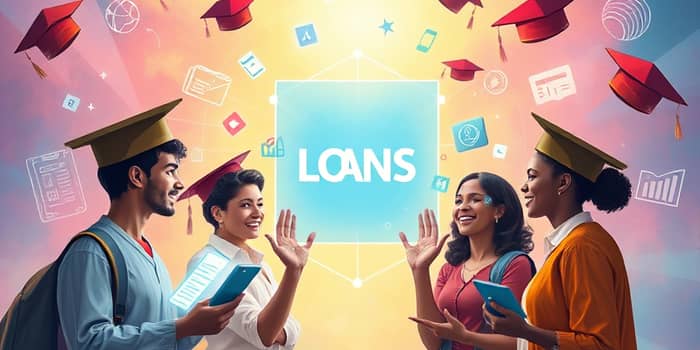In an era where educational costs continue to climb, digital loans have emerged as a transformative tool for ambitious learners. By harnessing technology, students can access funding quickly, compare options seamlessly, and take control of their financial futures. This article delves into the current landscape, explores innovative solutions, and provides practical strategies to minimize debt while maximizing the return on your educational investment.
Understanding the Current Student Loan Landscape
The United States faces an unprecedented student debt crisis, with total student loan balances reaching $1.777 trillion in early 2025. After a slight decline in 2023, debt levels began rising again in 2024, reflecting higher tuition costs and renewed borrowing.
Federal loans account for over 92.8% of this debt, while private loans represent a growing share. The average borrower carries $35,207 in debt, although this figure varies widely based on institution type, degree level, and geographic region. As more students explore digital lending platforms, understanding this backdrop is crucial for informed decision-making.
Exploring Digital Lending Options
Fintech companies and online portals have revolutionized the way students finance their education. By streamlining applications and offering real-time rate comparisons, digital loans provide transparent and accessible solutions that stand in contrast to traditional brick-and-mortar processes.
- Federal loan portals with automated eligibility checks
- Private digital lenders offering variable and fixed rates
- Income-Share Agreements (ISAs) linking repayment to future earnings
Whether you opt for a federal loan with generous deferment options or a private lender promising rapid approvals, it’s vital to compare rates, fees, and repayment flexibility before committing.
Tackling Repayment Challenges Head-On
Repayment remains one of the greatest hurdles for graduates. As of February 2025, 20.5% of borrowers are more than 90 days delinquent, a stark increase from the pre-pandemic rate of 11.5%. Subprime borrowers face even steeper challenges, with serious delinquency rates exceeding 50%.
Moreover, the Department of Education resumed collections on defaulted federal loans in May 2025, underlining the importance of proactive repayment strategies. By creating a realistic budget and exploring deferment or forbearance options, borrowers can take control of their financial trajectory and avoid long-term credit damage.
Building Essential Financial Literacy
One of the most powerful tools in your arsenal is comprehensive financial education. Understanding concepts like compound interest, time value of money, and budgeting fundamentals can drastically reduce the total cost of borrowing.
Educational institutions and nonprofit organizations are increasingly integrating financial literacy into orientation programs and curricula. By mastering skills such as financial planning and credit management, students can make smarter choices that will benefit them long after graduation.
Strategies for Minimizing Debt Before You Borrow
Borrowing should be your last resort, not the first step. Implement these strategies to keep debt levels manageable and align your loans with your career goals:
- Apply for scholarships and grants to cover tuition and living expenses
- Choose subsidized over unsubsidized federal loans when possible
- Assess the return on investment for each program you consider
- Create a detailed budget and repayment timeline before signing agreements
By carefully planning and exhausting alternative funding sources, you can significantly reduce the need for high-interest debt and maintain a healthier financial outlook.
Innovations and Future Trends in Education Financing
As tuition continues to rise, digital lenders are exploring new models to share risk and reward. Income-Share Agreements have gained traction, allowing students to pay a percentage of future earnings rather than fixed interest rates. Crowdfunding platforms are also emerging, enabling networks of supporters to invest in promising students.
On the policy front, lawmakers are debating reforms to make federal repayment plans more flexible and forgiving. Some proposals include capping monthly payments at a percentage of discretionary income and offering partial loan forgiveness after a set number of years in qualifying public service roles.
Case Study: A Roadmap to Success
Consider Sarah, a first-generation college student pursuing a computer science degree. Faced with rising tuition and limited family support, she approached education financing strategically:
First, Sarah researched scholarships tailored to STEM majors, securing $8,000 in awards. She then compared federal and private digital loans, ultimately choosing a subsidized federal loan for its lower rate and flexible repayment options.
Sarah used online budgeting tools to forecast her monthly expenses and enrolled in an income-driven repayment plan, ensuring her payments would remain manageable after graduation. She also invested time in free financial literacy workshops, learning to track spending and build emergency savings.
Today, Sarah graduates with less than $20,000 in debt, a clear plan to pay off her balance within five years, and a position at a leading tech firm. Her proactive approach illustrates how intentional borrowing decisions and digital tools can transform an intimidating financial journey into a sustainable investment in one’s future.
Digital loans for education represent more than just a funding mechanism; they embody empowerment through accessible finance. By understanding the landscape, embracing innovative solutions, and prioritizing financial literacy, students can navigate the complexities of borrowing with confidence.
Your educational ambitions deserve a solid financial foundation. As you explore loan options, remember that informed choices today will shape your opportunities tomorrow. Invest wisely, plan diligently, and watch your educational and professional dreams become reality.
References
- https://educationdata.org/student-loan-debt-statistics
- https://www.studentloanprofessor.com/student-loan-debt-statistics/
- https://newsroom.transunion.com/may-2025-student-loan-update/
- https://www.bestcolleges.com/research/average-student-loan-debt/
- https://fsapartners.ed.gov/knowledge-center/library/electronic-announcements/2025-05-05/request-institutions-provide-repayment-information-former-students-prevent-defaults
- https://www.nerdwallet.com/article/loans/student-loans/data-2025-high-school-grad
- https://www.investopedia.com/terms/f/financial-literacy.asp
- https://libertystreeteconomics.newyorkfed.org/2025/05/student-loan-delinquencies-are-back-and-credit-scores-take-a-tumble/










